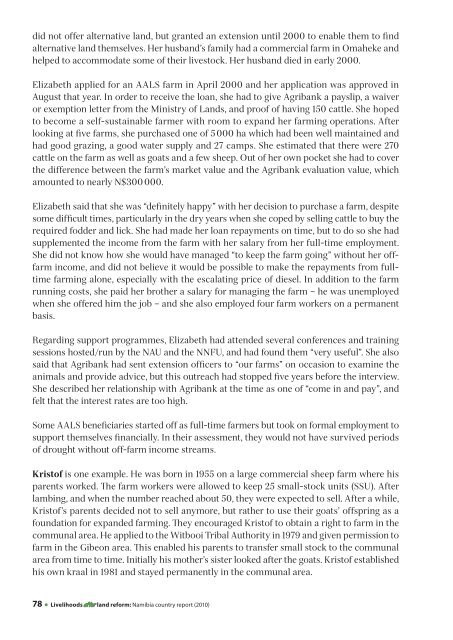Namibia country report
Namibia country report
Namibia country report
- No tags were found...
You also want an ePaper? Increase the reach of your titles
YUMPU automatically turns print PDFs into web optimized ePapers that Google loves.
did not offer alternative land, but granted an extension until 2000 to enable them to findalternative land themselves. Her husband’s family had a commercial farm in Omaheke andhelped to accommodate some of their livestock. Her husband died in early 2000.Elizabeth applied for an AALS farm in April 2000 and her application was approved inAugust that year. In order to receive the loan, she had to give Agribank a payslip, a waiveror exemption letter from the Ministry of Lands, and proof of having 150 cattle. She hopedto become a self-sustainable farmer with room to expand her farming operations. Afterlooking at five farms, she purchased one of 5 000 ha which had been well maintained andhad good grazing, a good water supply and 27 camps. She estimated that there were 270cattle on the farm as well as goats and a few sheep. Out of her own pocket she had to coverthe difference between the farm’s market value and the Agribank evaluation value, whichamounted to nearly N$300 000.Elizabeth said that she was “definitely happy” with her decision to purchase a farm, despitesome difficult times, particularly in the dry years when she coped by selling cattle to buy therequired fodder and lick. She had made her loan repayments on time, but to do so she hadsupplemented the income from the farm with her salary from her full-time employment.She did not know how she would have managed “to keep the farm going” without her offfarmincome, and did not believe it would be possible to make the repayments from fulltimefarming alone, especially with the escalating price of diesel. In addition to the farmrunning costs, she paid her brother a salary for managing the farm – he was unemployedwhen she offered him the job – and she also employed four farm workers on a permanentbasis.Regarding support programmes, Elizabeth had attended several conferences and trainingsessions hosted/run by the NAU and the NNFU, and had found them “very useful”. She alsosaid that Agribank had sent extension officers to “our farms” on occasion to examine theanimals and provide advice, but this outreach had stopped five years before the interview.She described her relationship with Agribank at the time as one of “come in and pay”, andfelt that the interest rates are too high.Some AALS beneficiaries started off as full-time farmers but took on formal employment tosupport themselves financially. In their assessment, they would not have survived periodsof drought without off-farm income streams.Kristof is one example. He was born in 1955 on a large commercial sheep farm where hisparents worked. The farm workers were allowed to keep 25 small-stock units (SSU). Afterlambing, and when the number reached about 50, they were expected to sell. After a while,Kristof’s parents decided not to sell anymore, but rather to use their goats’ offspring as afoundation for expanded farming. They encouraged Kristof to obtain a right to farm in thecommunal area. He applied to the Witbooi Tribal Authority in 1979 and given permission tofarm in the Gibeon area. This enabled his parents to transfer small stock to the communalarea from time to time. Initially his mother’s sister looked after the goats. Kristof establishedhis own kraal in 1981 and stayed permanently in the communal area.78 ● Livelihoods after land reform: <strong>Namibia</strong> <strong>country</strong> <strong>report</strong> (2010)
















